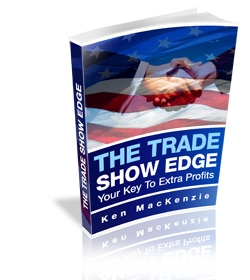Why do you have to urgently follow up on your trade show leads?
Attending a trade show can be a great way to generate leads for your business, but the real work begins after the show is over. Effective follow-up is key to converting those leads into paying customers.
In this article, we’ll discuss some best practices for trade show lead generation follow-up, including tips on how to prioritize and organize your leads, strategies for reaching out to potential customers, and ways to measure the success of your follow-up efforts. By implementing these strategies, you can ensure that your trade show leads don’t go to waste and that you make the most of the investment you made in attending the show.
It’s critical you follow up on your trade show leads quickly.

Post trade show evaluation and trade show lead follow-up are two of the most overlooked aspects of trade show participation.
These activities are where many trade show exhibitors fail usually because of a couple of reasons.
You return to the office to find your voicemail is overflowing; your inbox is full of emails and you need to check on your current projects and sales.
There’s an assumption that all the trade show leads you met at the show will phone you because you gave them a brochure and they are certain to remember you.
Therefore, it’s suggested that you first follow up with all urgent issues immediately and deal with existing client matters that have arisen while you’ve been away.
Start your trade show leads follow-up.
Then put aside all other non-critical matters and start your trade show leads follow-up.
By following up on your trade show leads right after the show tells your customers and prospects that your company cares about them and is responsive. According to the CEIR (Center for Exhibition Industry Research) over 80% of all trade show leads never receive post-event sales follow-up, so take your competitors’ customers and increase your show’s ROI —follow up on your trade show leads!
Just to reinforce this point, an astounding 43% of prospective buyers receive materials after they have made a buying decision with another vendor, while 18% report never receiving materials at all.
You must have a plan for immediate, post trade show leads follow-up.
The day after the show, your pile of trade show leads is worth 100 percent of its value. A month after the show, the leads are worth half of that, yet it still costs 100 percent in company time and resources to follow them up. Prepare all follow-up materials before the show. Identify necessary codes; write cover letters, order materials, and postage.

Hot prospects cool quickly. One way to prevent them from becoming lukewarm is to send follow-up information during the show. Prior to the show, prepare product information packages at your office, and either leave them with an assistant or transport them to the show. At each day’s end, address your packages to those hot prospects and drop them in the mail
Most trade shows do not end when the doors are closed and the key to success is to prioritize your post-trade show activities.
In order to achieve maximum results, the period after the exhibition is the most important phase of the whole exhibition project. First of all, you have to be quick to follow up on contacts made during the trade show and you have to be consistent and methodical in your approach. Sort your trade show leads either by their business potential (A, B, or C leads) or the information requested.
Steps to an effective trade show lead follow-up are:
![]() Trade show sales leads should be prioritized according to urgency.
Trade show sales leads should be prioritized according to urgency.
![]() Leads should be followed up immediately.
Leads should be followed up immediately.
![]() On an ongoing basis pursue leads.
On an ongoing basis pursue leads.
![]() Track leads to provide some measure of return on investment.
Track leads to provide some measure of return on investment.
Remember that Following up on trade show leads is a crucial step in maximizing the potential of your participation in a trade show. It allows you to build upon the connections made during the event and convert leads into valuable business opportunities.
Here are some key strategies and tips for effective follow-up of trade show leads:
Organize and prioritize leads:
After the trade show, take the time to organize and categorize your leads based on their potential value or interest. Prioritize leads that have shown a higher level of engagement or expressed specific interest in your products or services.
Promptness is key:
Time is of the essence when it comes to following up on trade show leads. Aim to reach out to your leads as soon as possible after the event, preferably within a week. This demonstrates your professionalism, keeps your brand fresh in their minds, and increases the chances of conversion.
Personalize your communication – trade show follow-up email:
Avoid sending generic or mass emails. Personalize your follow-up messages by referring to the conversations or interactions you had with each lead during the trade show. This personal touch shows that you value their time and attention, making them more likely to respond positively.
Provide value and solutions:
Focus on addressing the specific needs or pain points discussed during the trade show. Tailor your follow-up message to demonstrate how your products or services can provide solutions or add value to their business. This helps to establish your expertise and relevance in their minds.
Multiple touchpoints:
Don’t rely solely on one method of communication. Use a combination of email, phone calls, and social media to reach out to your leads. This multi-channel approach increases the chances of getting their attention and encourages a response.
Offer incentives or exclusive deals:
To incentivize prompt action, consider offering exclusive discounts, promotions, or incentives to your trade show leads. This creates a sense of urgency and motivates them to take the next step in the sales process.
Nurture long-term relationships:
Some trade show leads may not be ready to make an immediate purchase or commitment. In such cases, focus on nurturing long-term relationships. Stay in touch through periodic updates, newsletters, or relevant content that keeps your brand on their radar until they are ready to convert.
Track and measure results:
Implement a system to track and measure the effectiveness of your follow-up efforts. Monitor metrics such as response rates, conversion rates, and overall ROI to identify areas for improvement and refine your follow-up strategy for future trade shows.
Remember, effective follow-up is about building relationships and trust with your leads. By providing personalized attention, delivering value, and maintaining consistent communication, you can convert trade show leads into long-term, loyal customers.
Post trade show follow-up is essential to making the most of your investment.
As soon as you return from the trade show, (or certainly within 48 hours) you should phone or email all serious trade show leads and prospects to say “thank you” for stopping by at your booth; extend any offers made at the trade show and offer any product/service solutions.
Frequently Asked Questions (FAQ’s)
Q: Why is trade show lead follow-up important?
A: Trade show lead follow-up is crucial because it allows you to capitalize on the connections made during the event, nurture potential customers, and convert leads into sales. It demonstrates your company’s responsiveness and commitment to customer satisfaction.
Q: How soon should I follow up with trade show leads?
It’s best to follow up with trade show leads within 1-2 business days after the event. Prompt follow-up helps maintain the momentum and keeps your company fresh in the leads’ minds.
Q: What should I include in a trade show lead follow-up email?
A trade show lead follow-up email should be personalized, concise, and engaging. Start by thanking the lead for their time, reference the conversation or interaction at the event, highlight the key benefits of your product or service, and provide a clear call-to-action for further engagement or next steps.
Q: How can I make my trade show lead follow-up more effective?
To make your trade show lead follow-up more effective, consider personalizing your communication, offering exclusive incentives or discounts, providing relevant content or resources, and using a multi-channel approach (email, phone calls, social media) to connect with leads.
Q: What strategies can I use to increase trade show lead conversion rates?
To increase trade show lead conversion rates, focus on building relationships with leads through personalized follow-up, understanding their needs and pain points, addressing any objections or concerns, providing product demonstrations or trials, and offering post-show incentives or promotions.
Q: Should I use automation tools for trade show lead follow-up?
Automation tools can be beneficial for trade show lead follow-up, especially for managing large volumes of leads. However, it’s important to strike a balance between automation and personalization. Customize your messages and ensure they don’t sound too generic or impersonal.
Remember, effective trade show lead follow-up requires a well-defined plan and timely action.
Definitive Trade Show Planning and Evaluation | Will Pay Off If Done Correctly
Pre Trade Show Marketing is Critical
How to Develop a Trade Show Budget
As an Amazon Affiliate, I earn from qualifying purchases. TheTradeShowEdge.com is a participant in the Amazon Services LLC Associates Program, an affiliate advertising program designed to provide a means for sites to earn advertising fees by advertising and linking to Amazon.com.
Links on this trade show leads page are sponsored affiliate links and the owner makes a commission if you buy after clicking these links. The owner is not a bonafide user of this product. However, he has thoroughly researched it and provided a personal opinion only. This disclosure is in accordance with the Federal Trade Commission’s 16 CFR, Part 255: “Guides Concerning the Use of Endorsements and Testimonials in Advertising.”
